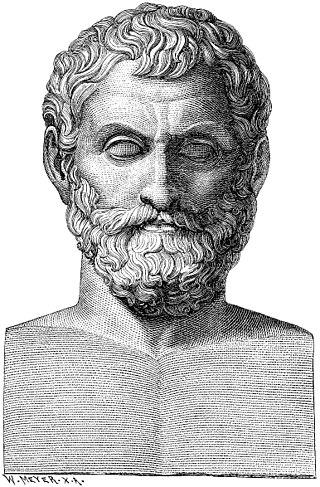
Anaximenes of Miletus was an Ancient Greek, Pre-Socratic philosopher from Miletus in Anatolia. He was the last of the three philosophers of the Milesian School, after Thales and Anaximander. These three are regarded by historians as the first philosophers of the Western world. Anaximenes is known for his belief that air is the arche, or the basic element of the universe from which all things are created. Little is known of Anaximenes' life and work, as all of his original texts are lost. Historians and philosophers have reconstructed information about Anaximenes by interpreting texts about him by later writers. All three Milesian philosophers were monists who believed in a single foundational source of everything: Anaximenes believed it to be air, while Thales and Anaximander believed it to be water and an undefined infinity, respectively. It is generally accepted that Anaximenes was instructed by Anaximander, and many of their philosophical ideas are similar. While Anaximenes was the preeminent Milesian philosopher in Ancient Greece, he is often given lower importance than the others in the modern day.

Isidore of Miletus was one of the two main Byzantine Greek mathematician, physicist and architects that Emperor Justinian I commissioned to design the cathedral Hagia Sophia in Constantinople from 532 to 537. He was born c. 475 AD. The creation of an important compilation of Archimedes' works has been attributed to him. The spurious Book XV from Euclid's Elements has been partly attributed to Isidore of Miletus.

Thales of Miletus was an Ancient Greek pre-Socratic philosopher from Miletus in Ionia, Asia Minor. Thales was one of the Seven Sages, founding figures of Ancient Greece, and credited with the saying "know thyself" which was inscribed on the Temple of Apollo at Delphi.

Miletus was an ancient Greek city on the western coast of Anatolia, near the mouth of the Maeander River in ancient Ionia. Its ruins are located near the modern village of Balat in Aydın Province, Turkey. Before the Persian rule that started in the 6th century BC, Miletus was considered among the greatest and wealthiest of Greek cities.

In Greek mythology, Hippomenes, also known as Melanion, was a son of the Arcadian Amphidamas or of King Megareus of Onchestus and the husband of Atalanta. He was known to have been one of the disciples of Chiron, and to have surpassed other disciples in his eagerness to undertake hard challenges. Inscriptions mention him as one of the Calydonian hunters.
Hecataeus of Miletus, son of Hegesander, was an early Greek historian and geographer.

The Büyük Menderes River, is a river in southwestern Turkey. It rises in west central Turkey near Dinar before flowing west through the Büyük Menderes graben until reaching the Aegean Sea in the proximity of the ancient Ionian city Miletus. The river was well known for its sinuous, curving pattern, and gives its name to the common term used to describe these characteristic bends in rivers.
The Cyclic Poets is a shorthand term for the early Greek epic poets, who were approximate contemporaries of Homer. No more is known about those poets than about Homer, but modern scholars regard them as having composed orally, as did Homer. In the classical period, surviving early epic poems were ascribed to those authors, just as the Iliad and Odyssey were ascribed to Homer. Together with Homer, whose Iliad covers a mere 50 days of the war, they cover the complete war "cycle", thus the name. Most modern scholars place Homer in the 8th century BC. The other poets listed below seemed to have lived in the 7th to the 5th centuries BC. Excluding Homer's, none of the works of the cyclic poets has survived.

Miletus symethus, the great brownie, is a small butterfly found in India that belongs to the lycaenids or blues family. The species was first described by Pieter Cramer in 1777.

Miletus biggsii, the Bigg's brownie, is a small butterfly found in India and Myanmar that belongs to the lycaenids or blues family.

Miletus is a genus of butterflies sometimes called brownies. Its species are found in the eastern Palearctic realm and the Indomalayan realm, and some stray east of the Wallace Line. The genus was erected by Jacob Hübner around 1819. Miletus is the type genus of the subfamily Miletinae.

Miletinae is a subfamily of the family Lycaenidae of butterflies, commonly called harvesters and woolly legs, and virtually unique among butterflies in having predatory larvae. Miletinae are entirely aphytophagous. The ecology of the Miletinae is little understood, but adults and larvae live in association with ants, and most known species feed on Hemiptera, though some, like Liphyra, feed on the ants themselves. The butterflies, ants, and hemipterans, in some cases, seem to have complex symbiotic relationships benefiting all.

Miletus chinensis, the common brownie, is a butterfly in the family Lycaenidae. It is found in South Asia

Miletus zinckenii is a butterfly in the family Lycaenidae. It is found on Java and Borneo.

Miletus croton is a butterfly in the family Lycaenidae. It is found in Asia.

Miletus mallus is a butterfly in the family Lycaenidae. It is found in Asia.

Miletus ancon is a butterfly in the family Lycaenidae. It is found in Southeast Asia.

Miletus leos is a butterfly in the family Lycaenidae. It is found in Asia.

Miletus gopara is a butterfly in the family Lycaenidae. It is found in Southeast Asia.

Miletus drucei is a butterfly in the family Lycaenidae. It is found in the Philippines and on Borneo.

















